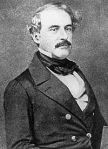… one of the most unjust [wars] ever waged by a stronger against a weaker nation …
That was how Ulysses S. Grant described the Mexican-American War of 1846-48 in his Personal Memoirs. Some two decades before he commanded the Union Armies during the American Civil War, Grant served in Mexico as a young lieutenant.
I ran across the quote back in 1998 while compiling a book of source materials about the war in Mexico. Grant’s eventual nemesis Robert E. Lee also served in that war as a captain. Did Lee share Grant’s bitterness about the conflict? While looking for an answer, I ran across a strangely haunting document. On April 12, 1848, shortly after the war’s end, Lee wrote a letter from Mexico City to a lady cousin back home in Virginia. The letter begins …
I rode out a few days since for the first time to the church of Our Lady of Remedios. It … is said to be the spot to which Cortez retreated after being driven from the city on the memorable Noche Triste.…
Lee refers here to the fabled Noche Triste of July 1, 1520, when Hernán Cortez and his army, routed by the Aztecs, fled Tenochtitlan. The letter continues …
I saw the cedar tree at Popotla … in which it is said he passed a portion of that night. The “trees of Noche Triste,” so called from their blooming about the period of that event, are now in full bloom. The flower is … of the most magnificent scarlet color I ever saw. I have two of them in my cup before me now. I wish I could send them to you.…
The letter fascinated me, evoking as it did an image of a man who would later play such a traitorous role in U.S. history treading in footsteps of that much earlier warrior, Hernán Cortez. As I read the rest of it, I wondered what thoughts and emotions lurked between its lines—homesickness, despair, horror, regret? I didn’t know then, and I don’t know now. But the question moved me to write this sestina, loosely based on Robert E. Lee’s letter …
Last night I rode out for the first time, lady—
rode west into the hills that looked like wax
molded by moonlight, and rested beneath a tree
with scarlet blossoms burdening its limbs.
(Even by night they were a brilliant hue.)
The night seemed sorrowful—a Noche Triste.
Long ago on another Noche Triste
(is not the night always a plaintive lady?)
a Spaniard fled, his moonlit face the hue
of pallid rout, as damp as fevered wax.
Conquered Cortés paused and rested his limbs,
weeping lost men and treasure beneath that tree.
I have two perfect blossoms from the tree
in a cup before me—twin flowers of Noche Triste.
They ease my soul, they please my aching limbs;
I wish that I could send them to you, lady.
I’ll bring you two facsimiles of wax,
but they can’t duplicate this scarlet hue.
As the moon shimmered yet more pale in hue,
I rode farther in hills beyond the tree
to where Cortés, conquistador of wax,
ended his retreat on that Noche Triste.
There stands the little chapel of Our Lady
settled beneath the sky’s nocturnal limbs.
Inside, I found the Virgin’s likeness—her limbs
clad in a petticoat of silver hue,
her head encircled with a crown. Our Lady
stood amid branches of a maguey tree,
and as befitted such a Noche, Triste
seemed to me her smile of lovely wax.
And all around her, shaped from pallid wax,
were sundry disembodied human limbs—
offerings left on some past Noche Triste
by those the Virgin healed. Their routed hue
whispered of sad Cortés beneath his tree;
and weary from my ride, I slumbered, lady,
and dreamed her tears were molten wax, the hue
of Our Lord’s bloody limbs nailed to a tree.
Ah, such a Noche Triste for Our Lady!


